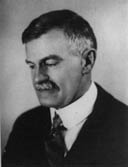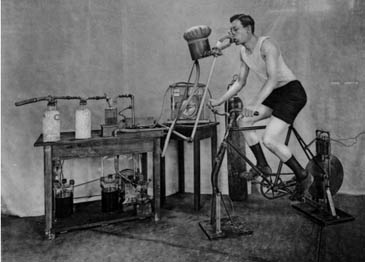Francis Gano Benedict (1870-1957)  A chemist, Benedict rose to prominence
when he assisted Atwater in the Department of Chemistry at Wesleyan University.
Over a 12-year period, they conducted over 500 experiments concerning
rest, exercise, and diet using the Atwater-Rosa respiration calorimeter.
Their results appeared in six bulletins of the Office of Experiment Stations
of the U.S. Department of Agriculture under the general title Experiments
on the Metabolism of Matter and Energy in the Human Body. In addition,
Benedict published studies on the physiological action of alcohol (which
proved to be controversial and opposed by the temperance organizations)
and the effects of muscular exercise and mental effort on energy metabolism.
When Atwater died in 1907, Benedict became Director of the Nutrition Laboratory
in Boston, a post he held for 30 years until retirement. A chemist, Benedict rose to prominence
when he assisted Atwater in the Department of Chemistry at Wesleyan University.
Over a 12-year period, they conducted over 500 experiments concerning
rest, exercise, and diet using the Atwater-Rosa respiration calorimeter.
Their results appeared in six bulletins of the Office of Experiment Stations
of the U.S. Department of Agriculture under the general title Experiments
on the Metabolism of Matter and Energy in the Human Body. In addition,
Benedict published studies on the physiological action of alcohol (which
proved to be controversial and opposed by the temperance organizations)
and the effects of muscular exercise and mental effort on energy metabolism.
When Atwater died in 1907, Benedict became Director of the Nutrition Laboratory
in Boston, a post he held for 30 years until retirement.
Relocating from Wesleyan to Boston provided Benedict with ready access to outstanding medical facilities. His work in respiratory metabolism complemented that of scientists in allied health fields such as renowned endocrinologist Elliot P. Joslin, who worked on diabetes (Joslin, 1912). Benedict studied metabolism in newborn infants, growing children and adolescents, starving people, athletes and vegetarians; he also investigated the effects of diet, temperature regulation, and exercise on metabolism. Traveling to Christian Bohr's laboratory in Copenhagen in 1907, he met August Krogh who won the 1920 Nobel Prize in Physiology or Medicine. The next summer, Benedict accompanied Krogh to Greenland to measure excretion of Eskimos. (Schmidt-Nielsen,1995)
In 1919, Harris and Benedict published their influential "metabolic standards" tables based on sex, age, height, and weight to compare normals and patients. In addition, Benedict published extensively in animal and agricultural nutrition. Collaborative research with E. C. Ritzman, University of New Hampshire at Durham, determined fat and carbohydrate usage relative to energy metabolism from the smallest mouse to an 1800-kg elephant. By modifying the respiratory apparatus, Benedict could accommodate lizards, turtles, birds, and snakes. His last monograph on basal metabolism refers to many of his approximately 400 publications (Benedict, 1938). Maynard (1969) chronicles Benedict's accomplishments, and a biography (DuBois and Riddle,1958) lists 300 of his publications. However, Benedict's work was not without detractors. Kleiber (1973) disparaged Benedict's method for expressing metabolic rate in wild and domesticated animals. © Frank I. Katch, William D. McArdle, Victor L. Katch. 1998. References Benedict, F.G. (1938). Vital energetics: a study in comparative basal metabolism. Washington DC: Carnegie Institution. DuBois, E., and Riddle, O. (1958). Biographical memoirs. National Academy of Science. XXXII, 67. Joslin, E.P. (1912). Metabolism in diabetes mellitus. Washington DC: Carnegie Institution. Kleiber, M. (1973). Body size and metabolic rate. In R. H. Catlett, (Ed.), Readings in Animal Energetics (7,600). New York: MSS Information Corporation. Maynard, L. A. (1969). Francis Gano Benedict-A biographical sketch, Journal of Nutrition, 98, 1. Schmidt-Nielsen, B. (1995). August & Marie Krogh. Lives in Science. New York: American Physiological Society, Oxford University Press. |

